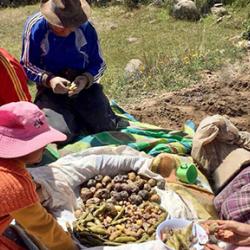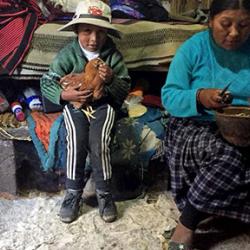Anel López de Romaña: A food ethnography in the Southern Peruvian Andes: women and changing peasant economic strategies in Amantaní, Puno
In 2019, I conducted a food ethnography in Amantaní, Puno, where I examined how subsistence peasant farmers foodways and systems transformed since the 1990s . Amantaní is an island in Lake Titicaca where subsistence family agriculture provides domestic units with most of their dietary intake. However, with the emergence of new labour and consumer markets in the last three decades, peasant diets mirror a rapid loss of their autonomy against the market, related to a new and heterogenous repertoire of reproductive strategies that transform the domestic use of time and labor. The following images mirror the islanders foodways shedding light on women’s activities, knowledge, discourses and strategies in this scenario.
Image 1: A Day harvesting with the domestic unit of Elsa Calsin
In this picture, a domestic unit - units of production (procurement) and consumption of food – appear sharing a meal in the field, where they had previously been harvesting different kinds of potatoes. The meal they are sharing is referred to as cocawi, a mixture of previously harvested crops: potatoes, ocas [Andean tuber], limabeans and chuño [freeze dried dehydrated potatoes]. After finishing the meal, the agricultural activities are resumed until evening falls or until the land has been cleared.
A harvest day starts as soon as the sun comes out when members of the domestic unit gather around the bonfire. However, women wake up even earlier, when it is still dark, to prepare the foods that will provide the food with sufficient energy throughout the intense working day under the unforgiving sun.
Image 2: Getting ready for a school day with Hilda and Nilton
Daily, Hilda faces the challenge of ensuring Nilton, her son, attends school with a full stomach and enough food in his backpack. On the morning of April 1st 2019, Hilda made vegetable broth with potatoes, onions, chuño, chicken, corn, and pumpkin. She explained she was running out of the vegetables and chicken her aunt had bought her in Juliaca. “Tomorrow [we will eat] only potato with chuño. Only potato with chuño and barley”.
While in Elsa’s domestic units, four adults can cooperate in food procurement; Hilda lives with her 8-year-old son and 80-year-old grandmother. She is responsible for sustaining the domestic unit’s food system by herself. She dedicates her time between agricultural activities and different strategies to acquire some money to purchase necessary foods like fruits, vegetables and protein, relying above all on her family and friends’ networks.
After Nilton left for school, we collected muña and toasted some barley. We packed muña mate in recycled bottles and separated the barley into small bagged portions. Then, we went to the dock to exchange potatoes for some bread or fish and sell the toasted barley and muña tea. We collected 14 soles (3.1 GBP) to buy more vegetables. Moreover, even though she could not exchange the harvested potatoes, she offered a store owner to carry goods from the boats to the store in exchange for a gallon of cooking gas.
Image 3: Women share ‘la comida de los antiguos’ [the food of the older peoples] in an event organized by the State’s representatives
This picture was taken during the anniversary of the Amantaní district foundation (1st April 2019). Local and national authorities and representatives of NGOs and state programs that provide economic and social aid to people living in poverty and extreme poverty arrived in the island for the occasion. Elderly men and women who benefit from the state social project Pension 65 (provides with cash transfers to 401 adults over 65 years old in Amantaní), were asked to expose their “traditional knowledge and practices” to the public. Women in the picture are offering ‘la comida de los antiguos’ (the food of the past), as part of their traditional knowledge.
When narrating their life histories, adult men and women would associate their childhood and ‘la comida de los antiguos’ with a time of hunger and suffering: “Then we ate no rice and noodles, we mostly ate barley, quinoa, all chuma (bland in quechua). We did not know many vegetables, or chicken or meat. Only when we killed sheep. We used to fight for food with my brothers. My mom sometimes didn’t eat, because we were many”. This narrative, however, is confronted with the discourse that in the past people ate healthier, less processed and more natural foods, that have now been replaced by products such as noodles, rice, canned meats and instant or precooked cereals.
In this picture, therefore, conflicting elements articulate, such as the revaluation of traditional practices, framed in the context of a higher presence of the state, the rise of tourism and new underlying power relations and the deepening of social inequalities in the island which cause an impoverishment of diet in terms of quality.
What the Judges said of Anel's images:
Stark and impactful, these photographs are beautifully explicated in accompanying text but speak volumes on their own terms. Despite the beauty of the persons, fabrics, and landscapes, these images possess a minimalism and simplicity that place the viewer right there among the candidate’s interlocutors, and teach us about the importance and all-consuming regularity of maintaining foodways.



